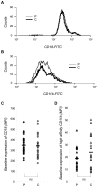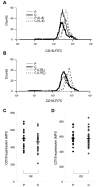Neutrophil activation status in stable coronary artery disease
- PMID: 17957240
- PMCID: PMC2020438
- DOI: 10.1371/journal.pone.0001056
Neutrophil activation status in stable coronary artery disease
Abstract
Background: During the last years, neutrophils have emerged as important players in atherogenesis. They are highly activated in peripheral blood of patients with unstable angina. Moreover, a primed state of circulating neutrophils has been proposed in patients with stable angina. Our aim was to investigate the neutrophil activation status in patients with stable coronary artery disease (CAD) at conventional drug treatment.
Methodology and principal findings: Thirty patients with stable CAD and 30 healthy controls were included using a paired design. The neutrophil expression of CD18 and high-affinity state of CD11b was analysed by flow cytometry before and after stimulation with chemoattractants. Also, the production of reactive oxygen species (ROS) was determined by chemiluminescence. During basal conditions, the neutrophil expression of CD18 or high-affinity state of CD11b did not differ between patients and controls. Chemoattractants (Interleukin-8 and Leukotriene B(4)) did not increase either the expression or the amount of high-affinity CD11b/CD18-integrins in CAD patients compared to controls, and had no effect on the production of ROS. On the other hand, the ROS production in response to C3bi-opsonised yeast particles and the neutrophils' inherent capacity to produce ROS were both significantly decreased in patients.
Conclusion/significance: We could not find any evidence that neutrophils in patients with stable CAD were primed, i.e. more prone to activation, compared to cells from healthy controls. According to our data, the circulating neutrophils in CAD patients rather showed an impaired activation status. It remains to be elucidated whether the neutrophil dysfunction in CAD is mainly a marker of chronic disease, an atherogenic factor or a consequence of the drug treatment.
Conflict of interest statement
Figures





Similar articles
-
Lipoxin A₄ inhibits porphyromonas gingivalis-induced aggregation and reactive oxygen species production by modulating neutrophil-platelet interaction and CD11b expression.Infect Immun. 2011 Apr;79(4):1489-97. doi: 10.1128/IAI.00777-10. Epub 2011 Jan 24. Infect Immun. 2011. PMID: 21263017 Free PMC article.
-
Enhanced neutrophil expression of annexin-1 in coronary artery disease.Metabolism. 2010 Mar;59(3):433-40. doi: 10.1016/j.metabol.2009.07.044. Epub 2009 Oct 21. Metabolism. 2010. PMID: 19850308
-
Clinical and angiographic correlates of leukocyte activation in unstable angina.J Am Coll Cardiol. 1995 Nov 1;26(5):1146-50. doi: 10.1016/0735-1097(95)00308-8. J Am Coll Cardiol. 1995. PMID: 7594025
-
Conformational activation of CD11b without shedding of L-selectin on circulating human neutrophils.J Leukoc Biol. 2007 Nov;82(5):1115-25. doi: 10.1189/jlb.0906545. Epub 2007 Aug 3. J Leukoc Biol. 2007. PMID: 17675559
-
β2 Integrin Signaling Cascade in Neutrophils: More Than a Single Function.Front Immunol. 2021 Feb 18;11:619925. doi: 10.3389/fimmu.2020.619925. eCollection 2020. Front Immunol. 2021. PMID: 33679708 Free PMC article. Review.
Cited by
-
Relation of leukocytes and its subsets counts with the severity of stable coronary artery disease in patients with diabetic mellitus.PLoS One. 2014 Mar 5;9(3):e90663. doi: 10.1371/journal.pone.0090663. eCollection 2014. PLoS One. 2014. PMID: 24599246 Free PMC article.
-
Association of fibrinogen with severity of stable coronary artery disease in patients with type 2 diabetic mellitus.Dis Markers. 2014;2014:485687. doi: 10.1155/2014/485687. Epub 2014 Apr 6. Dis Markers. 2014. PMID: 24803720 Free PMC article.
-
Regulation of Neutrophil Functions by Hv1/VSOP Voltage-Gated Proton Channels.Int J Mol Sci. 2021 Mar 5;22(5):2620. doi: 10.3390/ijms22052620. Int J Mol Sci. 2021. PMID: 33807711 Free PMC article. Review.
-
Association of Circulating Neutrophils with Relative Volume of Lipid-Rich Necrotic Core of Coronary Plaques in Stable Patients: A Substudy of SMARTool European Project.Life (Basel). 2023 Feb 2;13(2):428. doi: 10.3390/life13020428. Life (Basel). 2023. PMID: 36836785 Free PMC article.
-
Increased levels of leukocyte-derived MMP-9 in patients with stable angina pectoris.PLoS One. 2011 Apr 29;6(4):e19340. doi: 10.1371/journal.pone.0019340. PLoS One. 2011. PMID: 21559401 Free PMC article.
References
-
- Ott I, Neumann FJ, Gawaz M, Schmitt M, Schomig A. Increased neutrophil-platelet adhesion in patients with unstable angina. Circulation. 1996;94:1239–1246. - PubMed
-
- Buffon A, Biasucci LM, Liuzzo G, D'Onofrio G, Crea F, et al. Widespread coronary inflammation in unstable angina. N Engl J Med. 2002;347:5–12. - PubMed
-
- Patel PB, Pfau SE, Cleman MW, Brennan JJ, Howes C, et al. Comparison of coronary artery specific leukocyte-platelet conjugate formation in unstable versus stable angina pectoris. Am J Cardiol. 2004;93:410–413. - PubMed
-
- Naruko T, Ueda M, Haze K, van der Wal AC, van der Loos CM, et al. Neutrophil infiltration of culprit lesions in acute coronary syndromes. Circulation. 2002;106:2894–2900. - PubMed
-
- Madjid M, Awan I, Willerson JT, Casscells SW. Leukocyte count and coronary heart disease: implications for risk assessment. J Am Coll Cardiol. 2004;44:1945–1956. - PubMed
Publication types
MeSH terms
Substances
LinkOut - more resources
Full Text Sources
Medical
Research Materials
Miscellaneous

